Reblog If U A Lil Ugly
reblog if u a lil ugly
More Posts from Wandererklary and Others





Good luck! (ᵔᴥᵔ)











BACK-TO-SCHOOL PRINTABLES
School is going to be starting soon, so I decided to make a bunch of printables to try to be more organised from the very first day. I don’t know about you, but every year (until now), on the first day of classes, I would write down everything that the teacher was saying on random pieces of paper I could get my hands on, which I would end up losing the moment I walked out of the classroom. This year, I decided to change that so I made class info printable. I also made a lab tracker because I always lose my labs and then the teacher always asks for them at the end of the year… So for this year, I made a lab tracker ahead of time. I also made an assignment and test tracker so that I can have a pretty good idea as to what my final mark will be. I made some vocab and formula sheets too to make studying them a bit easier. I made a schedule printable because the schedule that my school gives every year is pretty ugly and I end up losing it. I made a weekly review so that I can make sure that I looked over everything I learned that week instead of just forgetting about it. I also made a daily planner because why not. There are also different versions of every printable so you can choose which one you like best. Other printables. Tag me with #msprintables
How many types plot structures are there and how are they used?
Hiya! Thanks for your question! Plot structures are important for creating a good story.
There’s an infinite amount of plot structures depending on the story you’re telling. Some types are better than others within certain genres. Here are the most common plot structures, and how they’re used:
The Four Main Plot Structures:
Freytag’s Pyramid:
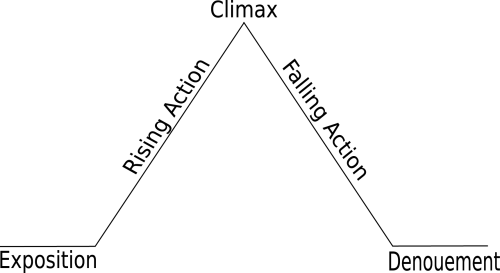
Also known as dramatic structure, this is the most simplistic of plot structures, and probably the one you were taught in elementary school. In this type of story structure, the climax falls in the middle, and the latter half of the story consists of falling action and the resolution. This was developed to analyze Greek and Shakespearian plays that use a five-act structure.
Why it’s good: It allows authors to explore the consequences of one’s actions. It’s also good for story analysis.
Why it’s bad: Long resolutions get boring fast. Modern novels don’t use this because no one wants to read a story where the villain is defeated in the middle.
When to use it: Children’s books and short stories
It’s good to use in children’s books because the goal of most children’s books is to teach kids a lesson. Using Freytag’s Pyramid gives writers the chance to teach kids the consequences of doing something wrong (lying, bullying, etc.). It works in short stories because the limited length prevents the denouement from being too long and boring the reader.
Examples: Any of Shakespeare’s plays
The Fichtean Curve:
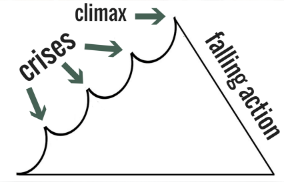
This is what most modern novels use, no matter the genre. The Fichtean Curve features a varying number of crises (or mini-climaxes) within the rising action to build up to climax about two-thirds of the way through the story. The falling action is short and used to wrap up loose ends or establish a new way of life for the characters.
Why it’s good: Putting crises throughout the story will keep readers hooked until the end. It also helps to keep good pacing. Despite being frequently used, this structure is loose enough that anyone can use it and make it unique for their own story.
Why it’s bad: Too much action can be overwhelming. This structure also doesn’t work well with certain story types such as Voyage and Return, Rebirth, or Comedy.
When to use it: Action-packed stories, Overcoming the Monster plots, or Quest plots
Examples: Night Circus by Erin Morgenstern, World War Z by Max Brooks, or Red Queen by Victoria Aveyard
The Hero’s Journey:
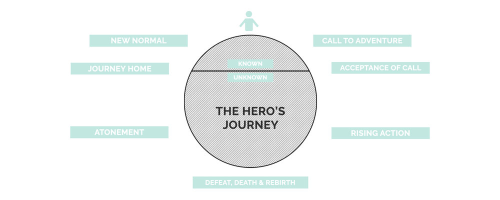
Another common plot structure that is seen in modern novels (especially western literature), and can be combined with the Fichtean Curve. Often, modern novels are a combination of the two. What makes the Hero’s Journey unique is that the protagonist must go through a literal or figurative death that completely transforms them. The death is usually, but not always, the climax of the story. Another key difference in The Hero’s Journey is that the protagonist must atone for their past rather than overcome it or move on without going back.
Why it’s good: Allows for great character development in character-strong stories.
Why it’s bad: Nearly every western novel, film, or TV show (successful and unsuccessful) uses this plot structure. It’s a little overdone, but if you can put a good personal twist on it, it can work out just fine.
When to use it: First-person stories, stories with small casts, Voyage and Return plots, or Rebirth plots
Examples: To Kill a Mockingbird by Harper Lee, The Lightning Thief by Rick Riordan, or Divergent by Veronica Roth
In Media Res
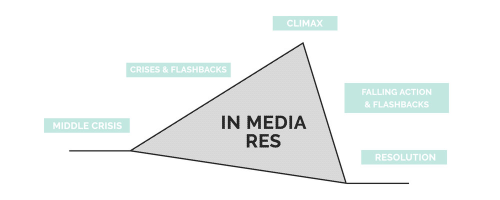
Latin for “in the middle of things”, In Media Res is a unique plot structure. Rather than start with an exposition that builds up to the action, In Media Res starts right in the middle of the story. If you were to start your story at the second or third crisis point of the Fichtean Curve, you would get In Media Res.
Why It’s Good: Dropping people in the middle of the action will hook the right from the beginning.
Why It’s Bad: Starting with the action can be disorienting for readers. Make sure you fill in the backstory as the plot moves on.
When to Use It: Stories with small casts, Crime plots, or Mystery plots
Examples: Hatchet by Gary Paulsen, The Lord of the Flies by William Golding, or The Iliad by Homer
There are plenty more plot structures, but these are the main four, and all others are based off these in some way. Keep in mind that most stories use a combination of these plot structures, so you don’t have to stick to just one.
Thanks again for your question! If you need help with anything else writing related, feel free to send in another ask. Happy writing!
- Mod Kellie
If you need advice on general writing or fanfiction, you should maybe ask us!
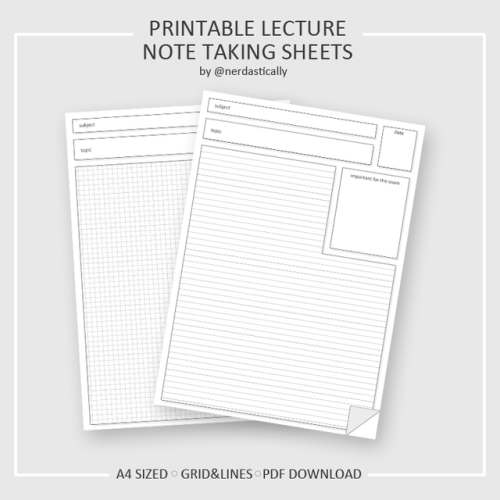
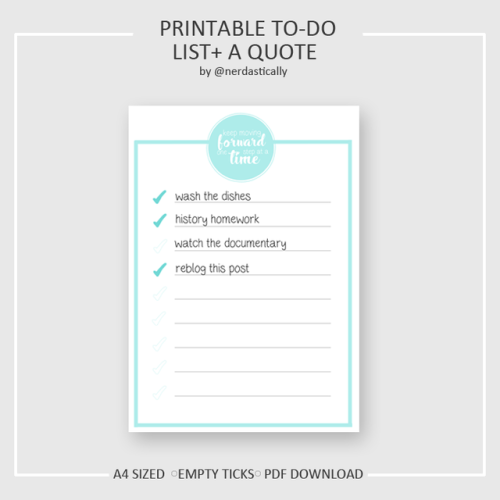
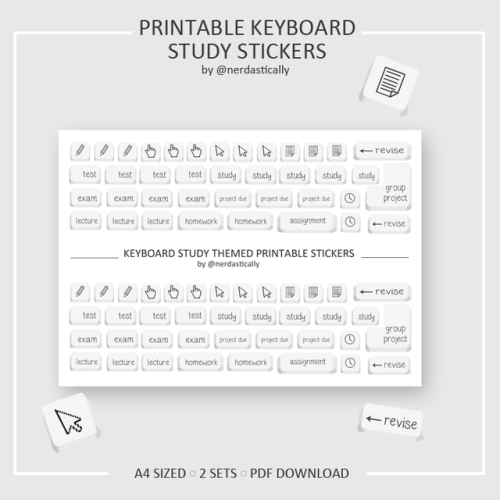
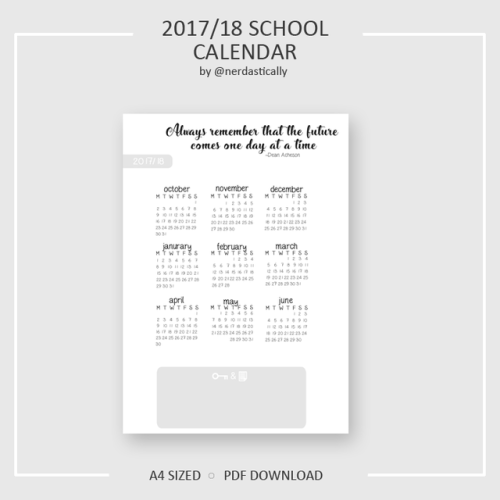
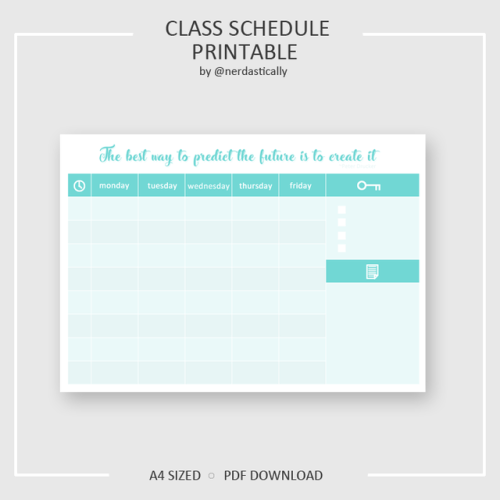
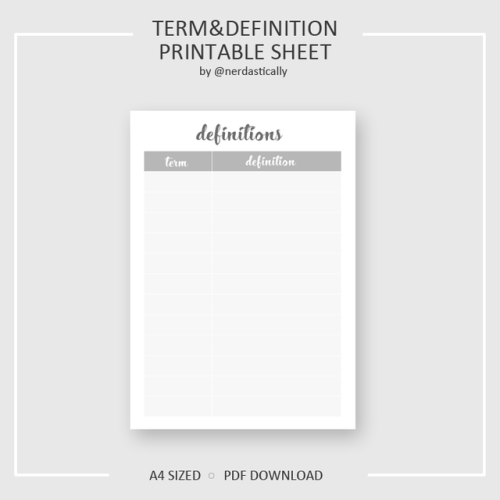
✨ back to school printables bundle ✨
back to school season has started, yay! As a ‘thank you’ to all 1000 people who followed me I made this printables bundle with everything you may need during your school year. I’m on uni so this is more of a ‘back to uni’ thingy, but I bet hs students will make a great use of it too! Anyway, thank you for following me and here goes!
Click one of the links below to download a PDF file:
▪️ grid note taking sheet [prev] ▪️ lined note taking sheet ▪️ to do list ▪️ keyboard stickers ▪️ 2017/18 school calendar ▪️ class schedule [prev] ▪️ term+definition sheet [A BUNDLE DOWNLOAD] - a zip file including more colors & PNG files! Please reblog/like this post if you found this useful!

Hey guys :) I’m Bea, from Exohypernova.
I wasn’t sure if I would post this because it’s my first ever printables pack and it has that overall design that is very very common in the studyblr comunity, and I didn’t want to post more of the same, but I had done this a while ago and thought maybe you guys would like it.
This pack contains:
✖ A habit tracker
✖ A life planner
✖ A month planner with productivity tracker
✖ A project management sheet
✖ A exam prep cheat sheet
✖ A book review page
✖ A book character review page
✖ A book tracker
✖ A glossary
✖ A task list
✖ A quotes sheet
✖ A formulas sheet
If you want to download all of them, you can click here to access my google drive folder. Also, if you have photoshop, you can download a totally editable version of those printables in this link (fonts included). ♡

Beauty must be appreciated. Cherish and admire the small things our earth gives. 😍

I believe in free education, one that’s available to everyone; no matter their race, gender, age, wealth, etc… This masterpost was created for every knowledge hungry individual out there. I hope it will serve you well. Enjoy!
FREE ONLINE COURSES (here are listed websites that provide huge variety of courses)
Alison
Coursera
FutureLearn
open2study
Khan Academy
edX
P2P U
Academic Earth
iversity
Stanford Online
MIT Open Courseware
Open Yale Courses
BBC Learning
OpenLearn
Carnegie Mellon University OLI
University of Reddit
Saylor
IDEAS, INSPIRATION & NEWS (websites which deliver educational content meant to entertain you and stimulate your brain)
TED
FORA
Big Think
99u
BBC Future
Seriously Amazing
How Stuff Works
Discovery News
National Geographic
Science News
Popular Science
IFLScience
YouTube Edu
NewScientist
DIY & HOW-TO’S (Don’t know how to do that? Want to learn how to do it yourself? Here are some great websites.)
wikiHow
Wonder How To
instructables
eHow
Howcast
MAKE
Do it yourself
FREE TEXTBOOKS & E-BOOKS
OpenStax CNX
Open Textbooks
Bookboon
Textbook Revolution
E-books Directory
FullBooks
Books Should Be Free
Classic Reader
Read Print
Project Gutenberg
AudioBooks For Free
LibriVox
Poem Hunter
Bartleby
MIT Classics
Many Books
Open Textbooks BCcampus
Open Textbook Library
WikiBooks
SCIENTIFIC ARTICLES & JOURNALS
Directory of Open Access Journals
Scitable
PLOS
Wiley Open Access
Springer Open
Oxford Open
Elsevier Open Access
ArXiv
Open Access Library
LEARN:
1. LANGUAGES
Duolingo
BBC Languages
Learn A Language
101languages
Memrise
Livemocha
Foreign Services Institute
My Languages
Surface Languages
Lingualia
OmniGlot
OpenCulture’s Language links
2. COMPUTER SCIENCE & PROGRAMMING
Codecademy
Programmr
GA Dash
CodeHS
w3schools
Code Avengers
Codelearn
The Code Player
Code School
Code.org
Programming Motherf*?$%#
Bento
Bucky’s room
WiBit
Learn Code the Hard Way
Mozilla Developer Network
Microsoft Virtual Academy
3. YOGA & MEDITATION
Learning Yoga
Learn Meditation
Yome
Free Meditation
Online Meditation
Do Yoga With Me
Yoga Learning Center
4. PHOTOGRAPHY & FILMMAKING
Exposure Guide
The Bastards Book of Photography
Cambridge in Color
Best Photo Lessons
Photography Course
Production Now
nyvs
Learn About Film
Film School Online
5. DRAWING & PAINTING
Enliighten
Ctrl+Paint
ArtGraphica
Google Cultural Institute
Drawspace
DragoArt
WetCanvas
6. INSTRUMENTS & MUSIC THEORY
Music Theory
Teoria
Music Theory Videos
Furmanczyk Academy of Music
Dave Conservatoire
Petrucci Music Library
Justin Guitar
Guitar Lessons
Piano Lessons
Zebra Keys
Play Bass Now
7. OTHER UNCATEGORIZED SKILLS
Investopedia
The Chess Website
Chesscademy
Chess.com
Spreeder
ReadSpeeder
First Aid for Free
First Aid Web
NHS Choices
Wolfram Demonstrations Project
Please feel free to add more learning focused websites.
*There are a lot more learning websites out there, but I picked the ones that are, as far as I’m aware, completely free and in my opinion the best/ most useful.
😱😱😱
for people who are unaware of why the riots in minneapolis started happening, here’s the facts:
it wasn’t george floyd’s protesters who started reacting violently; it was the cops.
the protest was peaceful until the cops showed up in riot gear, and started using water cannons, followed up by tear gas and rubber bullets. i got videos from friends who were there, of people screaming and running away from the cops shooting the water cannons, rubber bullets and throwing tear gas at them. they were even shooting at the protesters dragging people away to get medical attention.
speaking of medical attention, dispatch refused to provide any medical attention to the protesters. people literally had to drive their bleeding friends to the hospital because they refused to send ambulances.
cops are using non-lethal weapons in a lethal way. they shot rubber bullets into people’s heads and injured them. there’s dozens of photos of protesters with bleeding head wounds from the rubber bullets.
multiple people used police scanners and heard that there were undercover cops pretending to be violent protesters who were throwing rocks and whatnot at the police, with dozens of eyewitness accounts confirming that information.
the person who instigated all the chaos last night (it was a fire at an autozone) with the looting and burning buildings is highly suspected to be an undercover cop pretending to be a protester, because the video of him keeps getting taken down. protesters tried to stop him but couldn’t because he had a hammer and they were scared for their safety.
the cops jammed cell phone towers and cut live streams to interrupt broadcasts and to prevent people from seeing what was really going on and who actually started the violence.
the cops lied about protesters being armed and about throwing rocks and are literally trying to continue the violence happening and yet no one is holding them accountable for that.
and during all this, the cop that murdered george floyd still hasn’t been arrested. he has had more than ten complaints filed against him and was involved in three other civilian shootings in the past. and yet he’s still out free along with his three other buddies involved, probably sitting on his couch while all this chaos is happening.
so don’t get it twisted. the cops just want to change the narrative to make it look like they’re the wounded and righteous party, when they’re the ones who started reacting violently in the first place and are still acting violently. so don’t you ever forget who started this tragedy and murdered someone, and who are continuing to react to the situation with violence.
Introducing Language Printables

My boyfriend and I are trying to save up so we can rent a new place and get married, so we have been working hard on a new project: Japanese Learning Printables, which we’re selling on Etsy. He’s a professional graphic designer and I have been teaching languages since 2003, so we decided to put our professional skills together and design some products that we hope Japanese learners will find useful. Here’s a brief overview of what we’ve made so far: Language Study Printables Pack 1

This bundle contains eight different printables in PDF format, both in A4 and letter size. Colour and black and white versions are included.

There are New Kanji blank sheets for you to practice kanji, with spaces for mnemonics, stroke order, on’yomi and kun’yomi, example sentences and more. Language Exchange sheets allow you to document new vocabulary and phrases, as well as cultural points as you participate in language exchange, meaning you get more out of your experience and can review afterwards. There’s also space for feedback for your partner and goal tracking.

To increase productivity you can track your reading and study hours with these Reading Log and Study Log pages.

To keep track of new words or compounds you can use our New Vocabulary sheet, with space for readings, example sentences, so you can lean in context, and review tracking included. Learning in real-life context is particularly difficult for self-studiers, so with this in mind we designed this Grocery List printable, which you prepare at home, as you would a normal list, then take shopping so that you can use Japanese in context, even if you’re in a non-Japanese environment. Also included in the Language Study Printables Pack 1 are Anime Log and Drama Log trackers, where you can note down examples of words in context you encounter when watching Japanese TV, track where and when you heard them and monitor your reviews.

Beginners, Intermediate and Advanced Journal Prompt Printables There are three different levels available individually, or you can buy the bundle and get all three at a discount. Again the printables come in PDF format, including both A4 and letter size versions. Designed with self-studiers in mind, these packs cover basic to advanced Japanese, including topics on your interests, memories, goals, as well as your opinions on a variety of current events, cultural points and social issues. Each pack contains 31 unique language prompts, one for every day of the month.
Beginners Journal Prompts should be good for self-studiers who are at around JLPT N5/N4 level, or who are working through Genki I and II. Topics include writing about your environment and interests, whilst giving you opportunities to use beginner level grammar and vocabulary. An English translation cheat sheet is included to help you if you get lost.
Intermediate Journal Prompts would best suit those at about JLPT N3/N2, or working through a textbook like Tobira. Topics include writing for different purposes, talking about culture, re-telling anecdotes and expressing your opinions. An English translation cheat sheet is included to help you if you get lost.
Advanced Journal Prompts are designed for those at N2/N1 JLPT level, or beyond. They are written by a native Japanese speaker and are designed to help you create independent texts on engaging and relevant topics, whilst using advanced language skills such as persuasion, criticism, and expressing nuanced opinions that often appears at this level.

We really hope that you will take a look at LanguagePrintables on Etsy and favourite our store. We put a lot of thought into making these as useful as possible, and so we would very much appreciate your support through buying or simply reblogging this post. Thank you so much for taking the time to read this post, if you have any questions, please feel free to ask. If you have a request for a language learning printable you’d like to see on our store in the future, then please let us know!
-
 lanternwashere liked this · 1 week ago
lanternwashere liked this · 1 week ago -
 lanternwashere reblogged this · 1 week ago
lanternwashere reblogged this · 1 week ago -
 fang-magic liked this · 1 week ago
fang-magic liked this · 1 week ago -
 conwise liked this · 1 week ago
conwise liked this · 1 week ago -
 babehog liked this · 1 week ago
babehog liked this · 1 week ago -
 trashcat-ops reblogged this · 1 week ago
trashcat-ops reblogged this · 1 week ago -
 khgyr liked this · 1 week ago
khgyr liked this · 1 week ago -
 circusbutch liked this · 1 week ago
circusbutch liked this · 1 week ago -
 variance-of-stars reblogged this · 1 week ago
variance-of-stars reblogged this · 1 week ago -
 skelezombie reblogged this · 1 week ago
skelezombie reblogged this · 1 week ago -
 mtftk9 liked this · 1 week ago
mtftk9 liked this · 1 week ago -
 6mayhem reblogged this · 1 week ago
6mayhem reblogged this · 1 week ago -
 undead-gynoburst reblogged this · 1 week ago
undead-gynoburst reblogged this · 1 week ago -
 aufhocker reblogged this · 1 week ago
aufhocker reblogged this · 1 week ago -
 aufhocker liked this · 1 week ago
aufhocker liked this · 1 week ago -
 sainte666 reblogged this · 1 week ago
sainte666 reblogged this · 1 week ago -
 rainbow-starheart liked this · 1 week ago
rainbow-starheart liked this · 1 week ago -
 plumsilk liked this · 1 week ago
plumsilk liked this · 1 week ago -
 houndmother reblogged this · 1 week ago
houndmother reblogged this · 1 week ago -
 c4ndytuft reblogged this · 1 week ago
c4ndytuft reblogged this · 1 week ago -
 benihana-circumcision reblogged this · 1 week ago
benihana-circumcision reblogged this · 1 week ago -
 321bogwater reblogged this · 1 week ago
321bogwater reblogged this · 1 week ago -
 maplemonarchy reblogged this · 1 week ago
maplemonarchy reblogged this · 1 week ago -
 parisroach reblogged this · 1 week ago
parisroach reblogged this · 1 week ago -
 grasshopper36948 reblogged this · 1 week ago
grasshopper36948 reblogged this · 1 week ago -
 celesmiseri reblogged this · 1 week ago
celesmiseri reblogged this · 1 week ago -
 alienjoyer reblogged this · 1 week ago
alienjoyer reblogged this · 1 week ago -
 apollos-star reblogged this · 1 week ago
apollos-star reblogged this · 1 week ago -
 apollos-star liked this · 1 week ago
apollos-star liked this · 1 week ago -
 biocrafthero reblogged this · 1 week ago
biocrafthero reblogged this · 1 week ago -
 eydilily liked this · 1 week ago
eydilily liked this · 1 week ago -
 acosmicfool reblogged this · 1 week ago
acosmicfool reblogged this · 1 week ago -
 teaerrors reblogged this · 1 week ago
teaerrors reblogged this · 1 week ago -
 clopiya reblogged this · 1 week ago
clopiya reblogged this · 1 week ago -
 johanthefriskiestofbits reblogged this · 1 week ago
johanthefriskiestofbits reblogged this · 1 week ago -
 420blazeitken reblogged this · 1 week ago
420blazeitken reblogged this · 1 week ago -
 nogenderfoundcheckagain reblogged this · 1 week ago
nogenderfoundcheckagain reblogged this · 1 week ago -
 nogenderfoundcheckagain liked this · 1 week ago
nogenderfoundcheckagain liked this · 1 week ago -
 peeperonii liked this · 1 week ago
peeperonii liked this · 1 week ago -
 phoenix-lich reblogged this · 1 week ago
phoenix-lich reblogged this · 1 week ago -
 estrellukyperiwinkle reblogged this · 1 week ago
estrellukyperiwinkle reblogged this · 1 week ago -
 crookedthumb liked this · 1 week ago
crookedthumb liked this · 1 week ago -
 twoleggedmermaid reblogged this · 1 week ago
twoleggedmermaid reblogged this · 1 week ago -
 twoleggedmermaid liked this · 1 week ago
twoleggedmermaid liked this · 1 week ago -
 totally-not-a-psychopath reblogged this · 1 week ago
totally-not-a-psychopath reblogged this · 1 week ago -
 szakias reblogged this · 1 week ago
szakias reblogged this · 1 week ago -
 dyedviolet reblogged this · 1 week ago
dyedviolet reblogged this · 1 week ago -
 watterbotleop reblogged this · 1 week ago
watterbotleop reblogged this · 1 week ago
